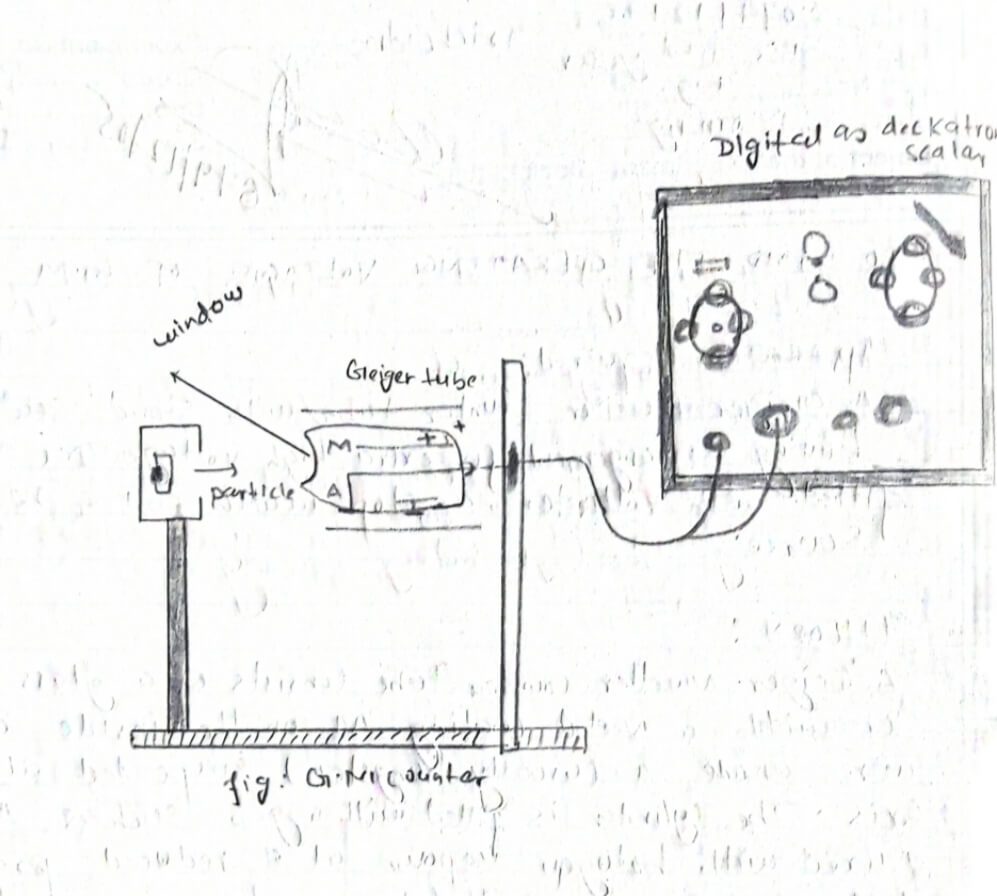APPARATUS REQUIRED
A Geiger muller counter tube with stand scalar unit having arrangement for extra high voltage D.C supply fitted with voltmeter, a stopwatch and a radioactive source.
THEORY
A Geiger muller counter tube consists of a glass cylinder C with a metal coating M on the inside and Co-axial wire anode A (usually tungsten) suspended along its axis. The cylinder is filled with a gas such as Argon, mixed with halogen vapor at a reduced pressure of 10 cm of mercury. The tube may have a very thin Mica and window w shielded by a protective gauge p. The metal tube is maintained at a negative potential of about 1000 volt with respect to the wire. The potential difference becomes M and A should be greater than certain threshold values but less than the voltage which would cause a continuous discharge of electricity through the gas. Under this condition a single ionizing particle like p- particle or a r-ray photons entering the counter through the end window will produce ionization of the gas Molecules. The ions are accelerated by the electric field and produce more ions by collision causing ionization current to built up rapidly which gives rise to an avalanche. The avalanche in turn produces an external resistance R. The resolving drop in potential across R reduces the potential across the tube below the threshold value and the current decay rapidly on the circuit has a small time constant. There is therefore a momentary source of current which is refered to as an electric pulse. Each pulse corresponds to one particle mentoring the counter.
The slope of plateau is given by
slope = N2 -N1/(V2 -V1)M X100…………..(i)
Where M= N2 +N1 / 2 N2 and N2 are counts
Per minute at voltage V1 and V2 respectively
The operating voltage of the G.M counter is given by
V= V1+⅓(V2-V1)
from graph we get,
V1 = 550
V2 = 950
Now, V= V1+⅓(V2-V1)
= 550+ 1/3(950-550)
= 550+ 1/3 X400
= 550+ 133.33
= 683.33V

OBSERVATION
Observation table:
| S.N. | Voltage | Observed counting rate with radioactive source (i) | Observed counting rate with radioactive source (N) | Observed counting rate with radioactive source mean (M) | Only background (b) | Corrected counting rate (poise sec) |
| 1 | 300 | 0 | 0 | 0 | 0 | 0 |
| 2 | 350 | 0 | 0 | 0 | 14 | -14 |
| 3 | 400 | 322 | 223 | 222.5 | 14 | 308.5 |
| 4 | 450 | 539 | 364 | 351.5 | 13 | 338.5 |
| 5 | 500 | 350 | 355 | 362.5 | 64 | 288.5 |
| 6 | 550 | 311 | 350 | 330.5 | 9 | 321.5 |
| 7 | 600 | 344 | 352 | 348 | 160 | 108 |
| 8 | 650 | 331 | 335 | 333 | 11 | 322 |
| 9 | 700 | 332 | 317 | 324.5 | 15 | 39.5 |
| 10 | 750 | 332 | 339 | 335.5 | 12 | 323.5 |
| 11 | 800 | 358 | 332 | 345 | 17 | 32.8 |
| 12 | 850 | 318 | 348 | 333 | 15 | 318 |
| 13 | 900 | 344 | 349 | 346.5 | 8 | 338.5 |
| 14 | 950 | 368 | 423 | 395.5 | 13 | 382.5 |
| 15 | 1000 | 3574 | 5018 | 4296 | 46 | 4250 |
CALCULATION
V =V1 +1/3 (V2-V1)
= 683.33V
RESULT
Hence the required operating voltage of G.M Counter is 683.33Volt.
PRECAUTIONS
i) The radioactive material Should be handled Carefully by a pair of tongs or forceps.
ii) The counting Switch should be always kept on so that the counting rate does not exceed. Excessive voltage will damage the G.M counter.
iii) The radioactive source should be placed in the source holder just below the Geiger tube below, increasing the high voltage slowly.
Explore More Physics Practicals | B.Sc. 2nd Year | T.U.
- Calculate the standard deviation, Error And Probable Error in Screw Gauge experiment
- Determine Acceleration Due to Gravity & Radius of Gyration | Bar Pendulum
- Determine Impedance of Series LCR Circuit | Formula & Experiment PDF
- Determine Modulus of Rigidity Using Maxwell’s Needle | PDF
- Determine Moment of Inertia & Angular Acceleration | Flywheel
- Determine Operating Voltage of G.M. Counter | Schematic & Guide
- Determine Specific Rotation of Sugar Solution Using a Polarimeter
- Determine Viscosity Coefficient of Water | Poiseuille’s Method
- Determine Young’s Modulus by Bending Beam Method | PDF
- Find Error in Slope Using Least Squares Method: Simple Pendulum Experiment”
- Find Impedance of LCR Series Circuit & Calculate Quality Factor
- Find Wavelength of Light Using a Diffraction Grating
- Find Wavelength of Sodium Light Using Newton’s Rings
- Study Charging & Discharging of Capacitor | Find Capacitance
- Study NPN Transistor Characteristics in Common Base Mode
